Khawaja Zaheer Ahmed - PDMA
Khawaja Zaheer Ahmed - PDMA
Khawaja Zaheer Ahmed - PDMA
You also want an ePaper? Increase the reach of your titles
YUMPU automatically turns print PDFs into web optimized ePapers that Google loves.
CHAPTER-4<br />
GEOGRAPHY OF PAKISTAN<br />
21. Pakistan is located in the Indus river basin and its delta, with rivers of<br />
Kabul, Jhelum, Chenab, Ravi and Sutlej as its main tributaries. Based on the<br />
Indus river system supplies, we boast of the largest irrigation network in the world<br />
though water availability for food and cash crops during critical seasons becomes<br />
acute, particularly in dry weather cycles. However, following independence in<br />
1947, problems regarding riparian rights with India emerged as an immediate<br />
issue resolved by ad-hoc responses. In 1960, the World Bank brokered Indus<br />
Water Treaty was signed, following imposition of extra-constitutional rule that<br />
granted an air-base to the USA in Peshawar. Under the Treaty, Pakistan<br />
conceded India’s rights over three eastern rivers: Ravi, Sutlej and Beeas<br />
whereas our primacy over Indus, Jhelum and Chenab was recognized; to make<br />
up for the ensuing water shortages from the rivers conceded to India, a system of<br />
Link Canals and construction of major water reservoirs was designed for<br />
gravitational transportation of water through economically viable softer soils in<br />
the Punjab plains. Earth-filled Mangla Dam on River Jhelum [boundary of the<br />
Punjab-Azad Jammu Kashmir] was the first to be constructed in 1960s, with<br />
appropriate power generation capacity; recently, its storage capacity has been<br />
increased by another 3.3 MAF by raising its height to originally contemplated<br />
level. Construction of rock filled Tarbela Dam [in the KP Province] followed in mid<br />
1970s, as the largest storage with power generation units since upgraded after<br />
ADB financed Ghazi-Brotha project in the last decade. More were to follow,<br />
preferably at 5-years interval: Kalabagh [Punjab-KP], and Diamer-Bhasha, Bunji<br />
and Dasu [Gilgit-Baltistan] being two other major projects but the priorities<br />
became controversial for various reasons, amongst the Provincial riparians.<br />
Rather than moving on for construction of other agreed options, almost 25 years<br />
were lost in the ‘to construct or not to construct’ paradigm. Stopgap short term<br />
options including increased reliance on thermal and gas fired power stations<br />
Page 81 of 211


